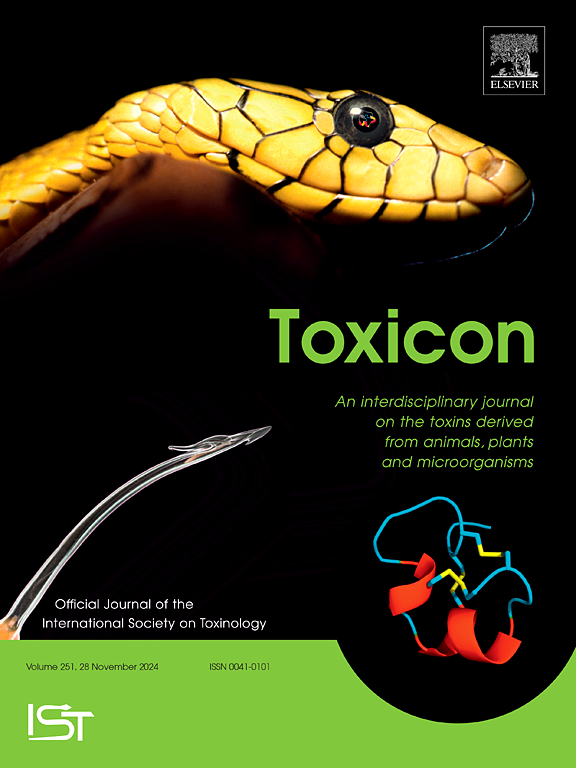Assessment of molluscicidal activity of Syzygium aromaticum essential oil against Eobania vermiculata under laboratory and field conditions
IF 2.6
4区 医学
Q2 PHARMACOLOGY & PHARMACY
引用次数: 0
Abstract
The present study focused on assessing the impact of clove oil on adult snails, specifically Eobania vermiculata, due to their detrimental effects on plants and crops. Our investigation aimed to explore both the lethal and sub-lethal toxicity of clove oil under laboratory and field conditions, with the goal of elucidating the mechanisms underlying its toxic effects on E. vermiculata. Snails were exposed to various concentrations of clove oil for one week to determine the LC50, which was calculated to be 5.25% v/v (4.029–6.087). To investigate the molluscicidal effects of clove oil, snails were divided into three groups: control, vehicle-treated (1 % Tween 80), and treated group exposed to sub-lethal concentration (½ LC₅₀) of clove oil for one week.
Compared to the control group, the exposure to ½ LC₅₀ of clove oil for 7 days resulted in significant increases in alkaline phosphatase (ALP), malondialdehyde (MDA), catalase (CAT), and superoxide dismutase (SOD). Conversely, the level of acetylecholnstrase (AChE) and glutathione peroxidase (GPx) was decreased. Furthermore, testosterone (T) and estrogen (E) levels were significantly reduced. Histological and ultrastructural studies revealed significant tissue disorganization. Additionally, Comet assay results confirmed the genotoxic potential of clove oil on E. vermiculata. Field trials demonstrated a higher reduction in snail populations in plots treated with methomyl (80% and 92% reduction after 7 and 14 days, respectively) compared to those treated with clove oil (64% and 73% reduction, respectively). While slightly less effective than methomyl, clove oil offers a valuable, natural, and residue-free alternative for eco-friendly snail management.

室内和野外条件下合欢精油对蛭形线虫的杀虫活性评价。
本研究的重点是评估丁香油对成年蜗牛(特别是蚯蚓)的影响,因为它们会对植物和农作物造成有害影响。我们的调查旨在探索丁香油在实验室和田间条件下的致死和亚致死毒性,目的是阐明丁香油对蚯蚓产生毒性影响的机制。将蜗牛暴露在不同浓度的丁香油中一周以确定半数致死浓度,计算得出的半数致死浓度为 5.25% v/v (4.029-6.087)。为研究丁香油的杀软体动物作用,蜗牛被分为三组:对照组、车辆处理组(1 % 吐温 80)和接触亚致死浓度(½ LC₅₀)丁香油一周的处理组。与对照组相比,接触 ½ LC₅₀丁香油 7 天后,碱性磷酸酶(ALP)、丙二醛(MDA)、过氧化氢酶(CAT)和超氧化物歧化酶(SOD)均显著增加。相反,乙酰胆碱酯酶(AChE)和谷胱甘肽过氧化物酶(GPx)的水平则有所下降。此外,睾酮(T)和雌激素(E)水平也明显降低。组织学和超微结构研究显示组织出现了明显的紊乱。此外,彗星测定结果证实了丁香油对 E. vermiculata 的潜在遗传毒性。田间试验表明,与使用丁香油处理的地块(分别减少 64% 和 73%)相比,使用灭多威处理的地块蜗牛数量减少得更多(7 天和 14 天后分别减少 80% 和 92%)。虽然丁香油的效果略逊于甲氧苄啶,但它为生态友好型蜗牛管理提供了一种宝贵、天然、无残留的替代品。
本文章由计算机程序翻译,如有差异,请以英文原文为准。
求助全文
约1分钟内获得全文
求助全文
来源期刊

Toxicon
医学-毒理学
CiteScore
4.80
自引率
10.70%
发文量
358
审稿时长
68 days
期刊介绍:
Toxicon has an open access mirror Toxicon: X, sharing the same aims and scope, editorial team, submission system and rigorous peer review. An introductory offer Toxicon: X - full waiver of the Open Access fee.
Toxicon''s "aims and scope" are to publish:
-articles containing the results of original research on problems related to toxins derived from animals, plants and microorganisms
-papers on novel findings related to the chemical, pharmacological, toxicological, and immunological properties of natural toxins
-molecular biological studies of toxins and other genes from poisonous and venomous organisms that advance understanding of the role or function of toxins
-clinical observations on poisoning and envenoming where a new therapeutic principle has been proposed or a decidedly superior clinical result has been obtained.
-material on the use of toxins as tools in studying biological processes and material on subjects related to venom and antivenom problems.
-articles on the translational application of toxins, for example as drugs and insecticides
-epidemiological studies on envenoming or poisoning, so long as they highlight a previously unrecognised medical problem or provide insight into the prevention or medical treatment of envenoming or poisoning. Retrospective surveys of hospital records, especially those lacking species identification, will not be considered for publication. Properly designed prospective community-based surveys are strongly encouraged.
-articles describing well-known activities of venoms, such as antibacterial, anticancer, and analgesic activities of arachnid venoms, without any attempt to define the mechanism of action or purify the active component, will not be considered for publication in Toxicon.
-review articles on problems related to toxinology.
To encourage the exchange of ideas, sections of the journal may be devoted to Short Communications, Letters to the Editor and activities of the affiliated societies.
 求助内容:
求助内容: 应助结果提醒方式:
应助结果提醒方式:


